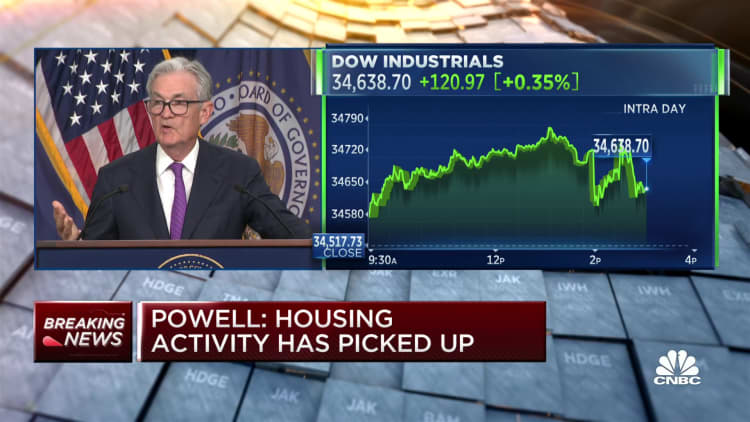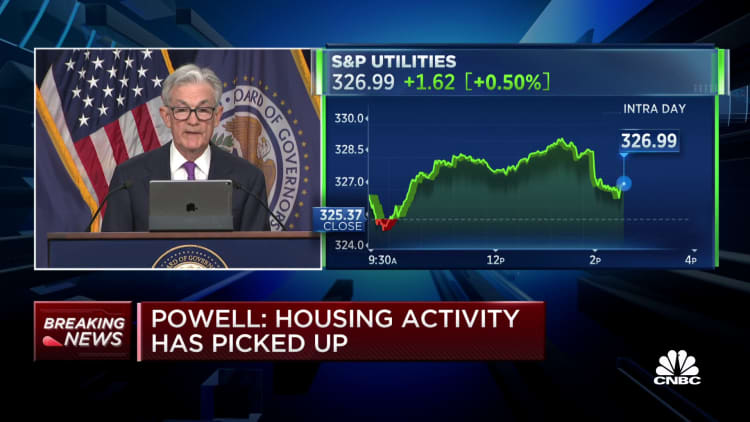- The Federal Reserve held off on a rate hike at its September meeting.
- Since March 2022, the central bank has raised its benchmark borrowing rate 11 times.
- Consumers have been feeling the impact as yields on savings and loans run higher.
The Federal Reserve skipped a rate hike in September, keeping the benchmark funds rate at a range of 5.25% to 5.5%. Fed Chair Jerome Powell the central bank's outlook on rates and the economy, as well as the likelihood of a soft landing.
While the Federal Reserve's latest release was more hawkish than expected, the main risk the the central bank faces is tarnishing its anti-inflation credibility, which warrants favoring their hawkish reaction, said Alexandra Wilson-Elizondo, deputy chief investment officer of multi-asset strategies at Goldman Sachs Asset Management.
The recent rise in energy prices and resilient economic activity data likely drove the Fed's forecasts, she said.
"We don't see a singular upcoming bearish catalyst, although strikes, the shutdown, and the resumption of student loan repayments collectively will sting and drive bumpiness in the data between now and their next decision," she said. "As a result, we believe that their next meeting will be live, but not a done deal."
— Michelle Fox
A government shutdown could limit the access the Federal Reserve has to inflation data it would typically use to help make its November rate decision. However, Fed Chair Jerome Powell said the central bank will just have to contend with that scenario if it happens.
"If there is a government shutdown and it lasts through the next meeting, then it's possible we wouldn't be getting some of the data that we ordinarily get," Powell said.
"We would just have to deal with that," Powell added. "It's hard for me to say in advance how that would affect that meeting. It would depend on all kinds of factors."
— Sarah Min, Jesse Pound and Jeff Cox

Fed Chair Jerome Powell said restoring price stability is the top priority of the central bank and failing to do that has serious consequences for the economy.
"The worst thing we can do is to fail to restore price stability, because the record is clear on that," Powell said. "If you don't restore price stability, inflation comes back and ... you can have a long period where the economy is just very uncertain, and it'll affect growth. It ... can be a miserable period to have inflation come constantly coming back and the Fed coming in and having to tighten again and again."
— Yun Li

Fed chair Jerome Powell threw cold water on the notion that a soft landing is a baseline scenario while taking questions from reporters on Wednesday.
When asked if a soft landing was a "baseline expectation," Powell immediately responded no before explaining that a the scenario was indeed possible.
"No, no, I would not do that. I've always thought that the soft landing was a plausible outcome, that there was a path to a soft landing," he said. "It's also possible that the path has narrowed and widened."
"Ultimately this may be decided by factors outside of our control at the end of the day, but I do think it's possible," Powell said. "I also think this is why we are in a position to move carefully, again. We will restore price stability, and we know we have to do that and we know that the public depends on us doing that."
— Brian Evans
The change to fewer projected rate cuts in 2024 has more to do with Fed officials' optimism about economic growth than a growing concern about stubborn inflation, Powell told reporters.
"Broadly, stronger activity means we have to do more with rates, and that's what that meeting is telling you," Powell said.
— Jesse Pound
The Fed is not yet fully convinced that inflation is on the right path, according to Chair Jerome Powell.
"We want to see convincing evidence really that we have reached the appropriate level, and we're seeing progress and we welcome that. But, you know, we need to see more progress before we'll be willing to reach that conclusion," Powell said.
— Jesse Pound
Federal Reserve chair Jerome Powell said Wednesday that while price pressures have shown some encouraging signs of easing, getting inflation back down to a 2% target is far from over.
"Inflation has moderated somewhat since the middle of last year, and longer-term inflation expectations appear to remain well anchored as reflected in a broad range of surveys of households, businesses and forecasters as well as measures from financial markets," Powell said.
"Nevertheless, the process of getting inflation sustainably down to 2% has a long way to go," he said.
-Brian Evans

The central bank signaled it would raise rates one more time this year before wrapping its policy tightening campaign, but investors should be aware of a key issue with the Fed's dot-plot projection.
"One glaring caveat: Dot plot medians tend to overestimate policy rates—sometimes by a wide margin," said Jeffrey Roach, chief economist at LPL Financial.
"The most egregious example was in 2015 when the Committee expected interest rates in 2017 to be above 3.50%, when in actuality they were closer to 0.50% that year," he added.
-Darla Mercado, Jeff Cox
The Federal Reserve signaled it could hike rates one more time this year after holding rates steady in September. However, one investor says no one is certain what the central bank will decide at its November meeting — least of all the Fed chief.
"The economy is growing stronger than the Fed thought and no one- not even Powell- knows what they will do in the 4th quarter," said Gina Bolvin, president of Bolvin Wealth Management Group.
"For sure the Fed is back to a neutral stance on balancing inflation vs employment. We are far from the recession many have predicted. We are closer to a soft landing," she added.
— Sarah Min
The Fed's September statement has only minor changes from July.
The central bank did change its description of economic growth to "solid" from "moderate" but also softened language around job growth.
Check out the full changes here.
— Jesse Pound
The S&P 500 slipped 0.1%, and the Nasdaq Composite declined 0.4% shortly after the Federal Reserve skipped a September hike, but indicated rates would be higher for longer.
The Dow Jones Industrial Average remained positive, but curtailed earlier gains, rising about 100 points.
-Darla Mercado
The Federal Reserve has held steady on interest rates, as markets had expected. That means the benchmark borrowing rate remains at 5.25% to 5.5%.
However, the central bank also indicated that rates will remain higher for longer.
Read more about the Fed's decision here.
-Darla Mercado, Jeff Cox
Leading up to the Federal Reserve's 2 p.m. decision, the S&P 500 traded about flat. The Nasdaq Composite was lower by 0.2%, and the Dow Jones Industrial Average was higher by nearly 180 points or 0.5%.
The 10-year Treasury yielded 4.31%, down about 4 basis points, while the 2-year Treasury inched lower by 5 basis points to trade at 5.05%.
-Darla Mercado
Investors will keep an eye out for hints from the Federal Reserve on how policymakers may move forward at the November meeting, but they are likely to be disappointed, said Russell Investments' BeiChen Lin.
"Although the Fed will be releasing updated dot plots that will show how Fed members see interest rates evolving, [Chair Jerome] Powell will likely continue to emphasize that those are merely projections, and not a pre-set course," said Lin, investment strategy analyst at Russell.
He expects that Powell will go "through a plethora of ways to say, 'No, we have not yet made up our mind about the November meeting.'"
"Could the markets become optimistic in the near term if the dot plots imply we won't see a November hike? Yes," he said. "But we wouldn't celebrate too quickly."
"We would stay disciplined and refrain from chasing any near-term excitement in the equity markets, Lin added.
-Darla Mercado
The Federal Reserve is widely expected to hold steady on its rate policy Wednesday afternoon, but the central bank's work has already had a sizeable impact on consumers.
Since the Fed has embarked on its rate hiking, the annual percentage yield on a five-year certificate of deposit has jumped to 2.83% as of the week of Sept. 15, according to data from Haver. That compares to a meager 0.5% during the week of March 11, 2022. Yields on money market funds have also leapt to 0.56% from 0.08%, Haver found.
Even Treasurys are proving to be exciting. The two-year Treasury yield was 5.06% Wednesday morning. It was 1.75% on the week of March 11, 2022, according to LSEG.
Higher rates are also hitting spenders in the pocketbook. Credit card rates were 20.71% as of last week, according to Bankrate. That compares to 16.34% during the week of March 11, 2022.
Further, the total interest paid on a $350,000 mortgage at 7.29% would be about $513,000 over the life of the 30-year note, according to Bankrate. A borrower would have paid $273,000 in interest on the same note back when the rate was 4.29%.
-Nick Wells, Darla Mercado
The Federal Reserve is expected to keep steady on the benchmark borrowing rate at the end of its September policy meeting, but investors will likely have a close eye on the central bank's economic updates.
In addition to the rate decision, the Fed will also issue its dot plot, which spells out policymakers' expectations for rates. In particular, the "longer run" median dot – an indication of where rates are headed beyond 2026 – will likely be a focal point for traders.
The Fed's summary of economic projections is also on deck, detailing the central bank's outlook for rates, GDP growth inflation and other key metrics.
Naturally, all eyes will be on Fed Chair Jerome Powell as he takes the podium at 2:30 p.m. ET and speaks to the press. He will offer further detail on policymakers' latest decision.
Read more about what to expect from the central bank here.
-Darla Mercado, Jeff Cox